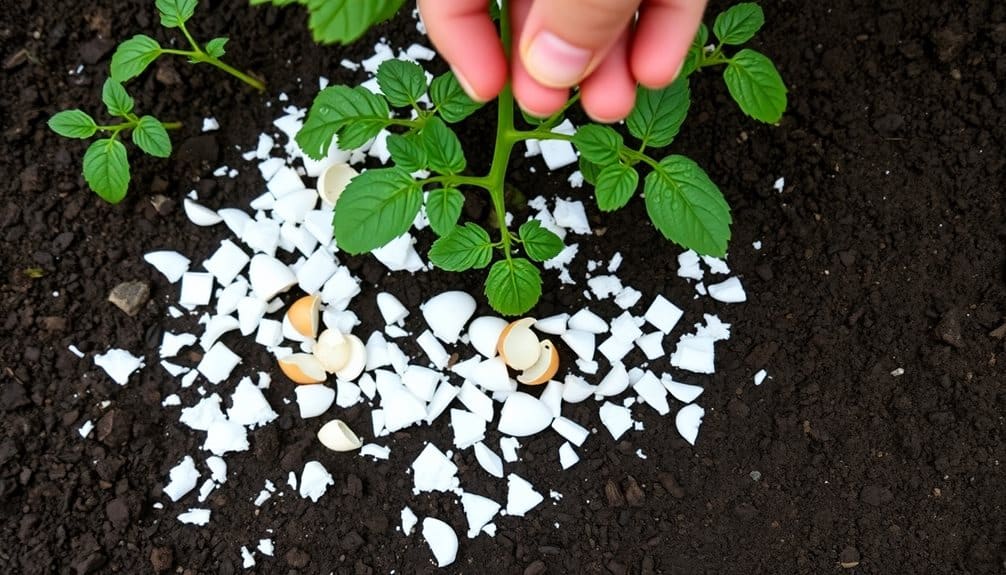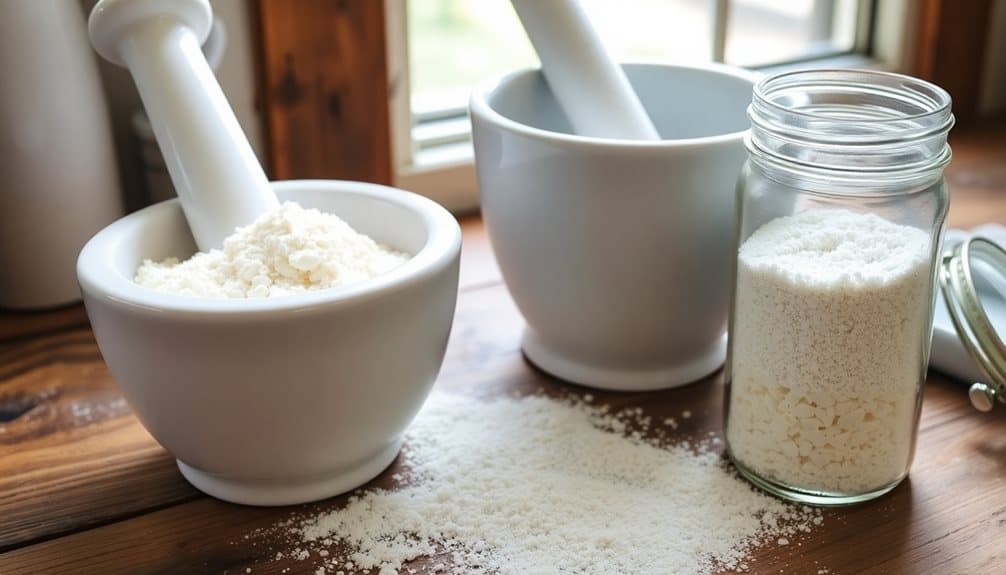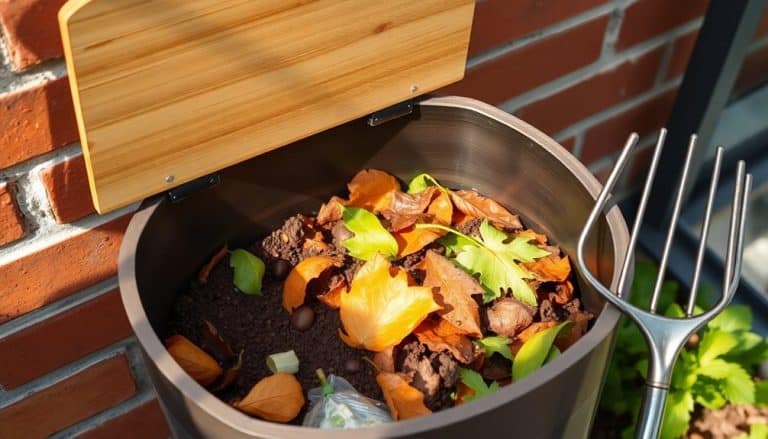This website contains affiliate links. Some products are gifted by the brand to test. As an Amazon Associate, I earn from qualifying purchases. The content on this website was created with the help of AI.
You can compost eggshells through five effective methods to enrich your garden soil with calcium. Directly apply finely ground, sterilized shells at 4-5 shells per square foot, or create a powder using a blender for targeted application around plants. Add crushed shells to your worm bin at one tablespoon per square foot monthly to support worm health and reproduction. For traditional composting, layer crushed shells with nitrogen-rich materials in your slow compost pile’s center. Alternatively, combine shells with used coffee grounds in a 1:2 ratio for enhanced mineral content. These sustainable practices transform kitchen waste into valuable garden nutrients, with each method offering unique benefits for your soil’s health.
Key Takeaways
- Grind clean eggshells into fine powder and mix directly into garden soil at 4-5 shells per square foot.
- Process dried eggshells in a blender until powdery, store in airtight containers, and apply monthly around plants.
- Add crushed eggshells to worm bins monthly, using one tablespoon per square foot to support worm health.
- Layer crushed eggshells in compost piles with nitrogen and carbon materials, maintaining 130-150°F core temperature.
- Mix crushed eggshells with coffee grounds in 1:2 ratio and layer with nitrogen-rich materials for enhanced decomposition.
Direct Garden Application

While scattering crushed eggshells directly into your garden might seem like a quick solution, it’s not the most efficient way to release calcium into the soil. The shells need to be broken down into extremely fine particles before plants can utilize their nutrients effectively. If you’re planning direct application, you’ll need to grind the shells into a powder using a coffee grinder or mortar and pestle.
Before grinding, you should sterilize your eggshells by baking them at 225°F (107°C) for 20 minutes to eliminate potential pathogens. Once you’ve created your eggshell powder, you can apply it to your garden soil at a rate of about 4-5 shells per square foot. Focus on applying the powder around plants that are heavy calcium feeders, such as tomatoes, peppers, and leafy greens.
You’ll get better results if you work the powder into the top 6 inches of soil rather than just spreading it on the surface. For maximum effectiveness, combine your eggshell application with slightly acidic organic matter, which helps facilitate calcium absorption by plant roots. Using soil amendments regularly can significantly improve your garden’s overall nutrient content and plant health.
Blender Powder Method

Efficiency drives the blender powder method as one of the quickest ways to transform eggshells into a calcium-rich soil amendment. You’ll need to start by thoroughly cleaning your eggshells and removing the inner membrane to prevent any protein residue from causing odors. After cleaning, let the shells air-dry completely for 24-48 hours to guarantee ideal grinding results.
Place your dried eggshells in a high-powered blender or food processor, securing the lid tightly. Pulse the shells in short bursts until they’re reduced to a fine, flour-like powder. You’ll want to achieve a texture similar to ground coffee for maximum soil absorption. Store your powdered eggshells in an airtight container to prevent moisture absorption.
When you’re ready to use the powder, you can either sprinkle it directly around your plants or mix it into your compost pile. The powder’s increased surface area allows for faster decomposition and quicker calcium uptake by your plants. For calcium-loving plants like tomatoes and peppers, apply 1-2 tablespoons of powder around each plant’s base monthly during the growing season. Using this method can help divert household waste from landfills while creating nutrient-rich compost for your garden.
Worm Bin Composting

Through vermicomposting, eggshells can provide essential calcium to your worm bin’s ecosystem while creating nutrient-rich castings. Red wigglers and other composting worms need calcium for reproduction and maintaining their body structure. You’ll want to crush your cleaned eggshells into small pieces before adding them to prevent sharp edges from harming the worms.
Add crushed eggshells sparingly, using approximately one tablespoon per square foot of bin surface area each month. You’ll notice the worms will consume the shells gradually, and they’ll use the rough edges to help grind food in their gizzards. The calcium carbonate in the shells also helps maintain your bin’s pH balance, preventing it from becoming too acidic.
For best results, mix the crushed shells into the top layer of bedding where the worms are most active. Don’t worry if you see pieces of shell in your finished castings – they’ll continue to break down and enrich your garden soil. The combination of worm castings and decomposed eggshells creates an excellent soil amendment that’s rich in both calcium and other essential minerals your plants need. Using a quality pitchfork helps you gently turn and mix the eggshells into your worm composting system without disturbing the worms.
Slow Compost Pile

Traditional slow compost piles provide an ideal environment for breaking down eggshells over a 6-12 month period. You’ll need to crush your eggshells into small pieces before adding them to maximize decomposition efficiency. Layer them between nitrogen-rich materials like kitchen scraps and carbon-rich items such as dried leaves or paper to maintain proper balance.
For best results, you’ll want to position your eggshells in the center of your pile where moisture and heat levels are highest. The pile’s core temperature should reach 130-150°F (54-66°C) to support microbial activity. Turn your pile every 4-6 weeks to incorporate the eggshells with other materials and guarantee even decomposition.
You can accelerate the breakdown process by grinding your eggshells into a fine powder before adding them. This increases their surface area and allows soil microorganisms to break them down more quickly. While decomposing, the calcium carbonate in eggshells will gradually release into your compost, creating a calcium-rich amendment that’s perfect for tomatoes, peppers, and other calcium-loving plants in your garden. Avoid mixing in meat and fish scraps with your eggshells, as these materials can attract pests and create unpleasant odors in your compost pile.
Coffee Ground Mixture

Coffee grounds and eggshells create a powerful composting duo that accelerates the breakdown of both materials. When you combine these two kitchen waste products, you’ll create an ideal environment for decomposition due to the complementary chemical properties. The acidic coffee grounds help break down the alkaline calcium carbonate in the shells, while the shells provide essential minerals and help maintain proper moisture levels.
To create this mixture, crush your cleaned eggshells into small pieces (aim for fragments smaller than 1/4 inch) and combine them with used coffee grounds at a 1:2 ratio. You’ll want to layer this mixture with other nitrogen-rich materials like grass clippings or food scraps. The coffee grounds provide nitrogen while the eggshells offer calcium and other trace minerals.
You can add this mixture directly to your garden soil or incorporate it into your existing compost bin. If you’re adding it to plants, maintain a 2-inch buffer zone between the mixture and plant stems. The combination will gradually release nutrients while improving soil structure and helping to deter certain garden pests that are sensitive to caffeine compounds. Using a stainless steel aerator will help thoroughly mix these materials for optimal decomposition and nutrient distribution.
Frequently Asked Questions
Can Eggshells From Boiled Eggs Be Composted?
Yes, you can compost eggshells from boiled eggs. The cooking process doesn’t affect their calcium carbonate composition or their compostability. You’ll want to crush them into smaller pieces to speed up decomposition, as intact shells break down slowly. They’ll enrich your compost with calcium and minerals while helping maintain pH balance. As a bonus, they’ll also deter slugs and snails in your garden.
How Long Do Eggshells Take to Decompose Naturally?
Like tiny calcium fortresses, eggshells can take your patience to the test – they’ll decompose naturally in about one to three years. You’ll notice they break down even slower in your backyard than other organic materials because of their hardy calcium carbonate structure. If you’re keen to speed up this process, you can crush them into powder-like particles, which will decompose in a few months.
Should Eggshell Membranes Be Removed Before Composting?
You don’t need to remove eggshell membranes before composting, as they’ll naturally decompose along with the shells. The membrane actually contains beneficial nutrients like protein and collagen that can enrich your compost. While you can peel them off if you prefer, it’s an unnecessary step that won’t greatly impact decomposition. The membrane will break down faster than the calcium-rich shell itself.
Can Colored or Decorated Easter Egg Shells Be Composted?
Like a toxic wolf in sheep’s clothing, decorated Easter eggs can harbor hidden dangers for your compost. If you’ve used natural dyes like beets or turmeric, you’re in the clear – these shells can safely decompose. However, you’ll want to avoid composting eggs decorated with synthetic dyes, stickers, glitter, or artificial colorings, as they can introduce unwanted chemicals into your nutrient-rich compost pile.
Do Eggshells Attract Unwanted Pests to the Compost Area?
While eggshells don’t typically attract pests to your compost, you’ll want to crush them finely and bury them within your pile. Their calcium content actually deters many common garden pests like slugs and snails. If you’re noticing pest issues, it’s likely due to other food scraps in your compost. You can minimize pest attraction by maintaining proper carbon-to-nitrogen ratios and covering fresh additions with brown materials.




